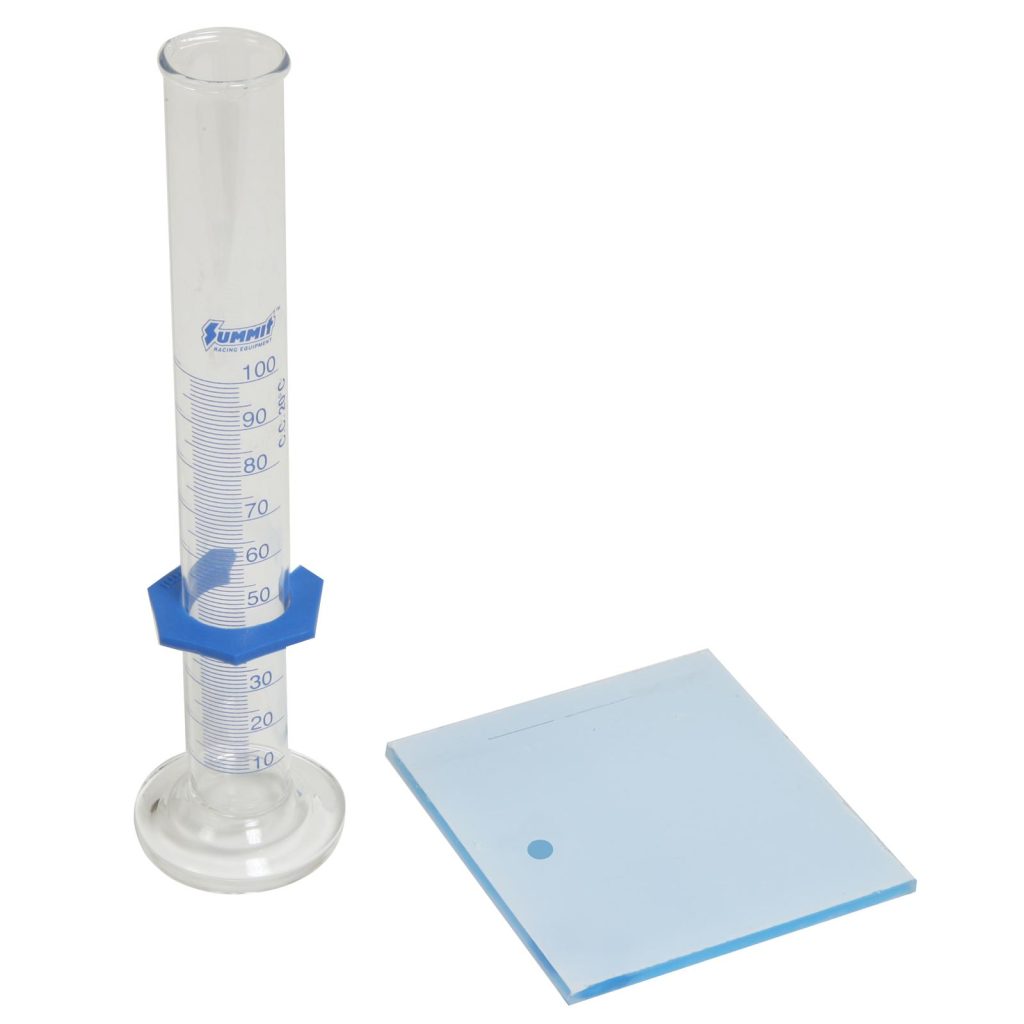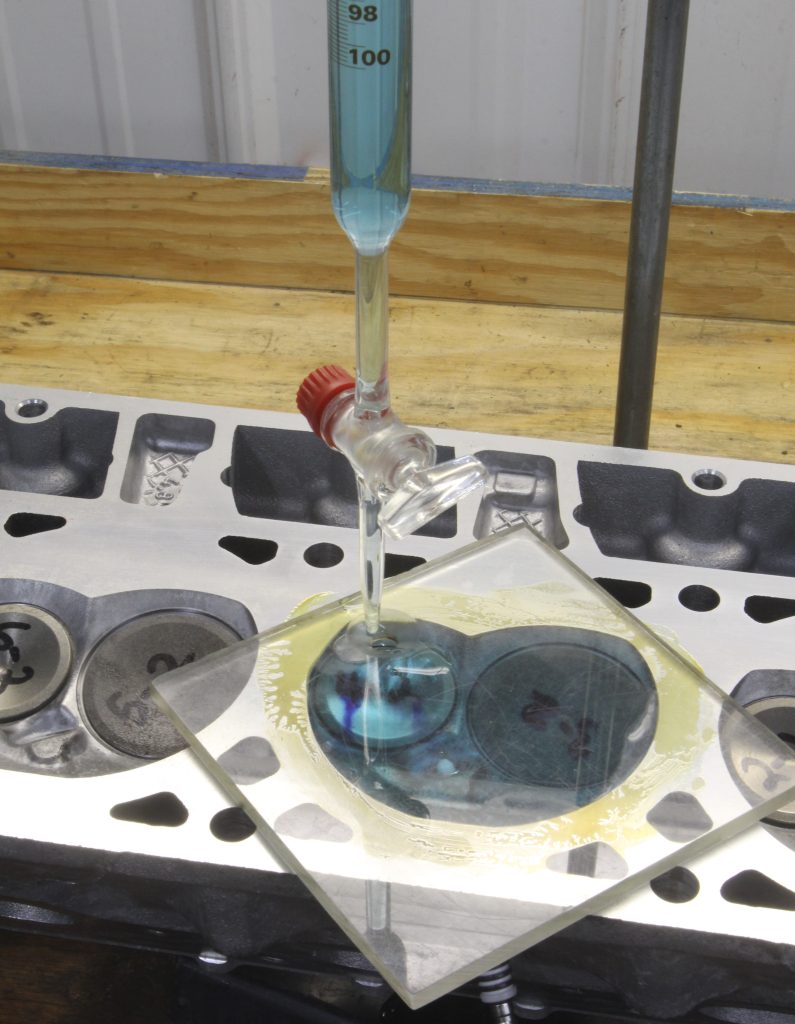I have a 355ci small block Chevy that I bought that has dished pistons but I don’t know anything about them. The heads are off right now. I’d like to figure out what the compression ratio is with a set of iron 64cc cylinder heads but I’m at a loss since I don’t know anything about the pistons. I’m sure there must be a way to do this. Can you help?
A.T.
Figuring out the compression ratio is actually a fairly easy procedure and with today’s inexpensive tools, you can perform the entire process is a few minutes.
In the old days, measuring combustion chamber or piston volume required an expensive, laboratory grade 100cc graduated cylinder and a dedicated metal stand and clamp. I think I paid over $100 for one of these about 40 years ago—now, you can find a complete beaker and chamber plate kit from Summit Racing for around $30 that has everything you need all in one kit!

Calculating Cylinder Volume
In order to determine the volume of the dish in the piston, we will need to first determine the volume of the cylinder at a given depth. We need to compute this volume in order to compare it with the volume of the dish in the piston.
Let’s start by assuming the piston is exactly 0.100 inch down from the deck. You can choose any distance you want but don’t go too far down in the hole or you will exceed the cubic centimeter (cc) volume of the beaker which just over-complicates this process.
First let’s determine the volume of the cylinder. Let’s say that the bore is 4.030 inches and the piston is 0.100 inch down in the bore. We will calculate the volume of a cylinder that will be produced in cubic inches and then convert to cubic centimeters.
- Volume of Cylinder = Pi x Radius x Radius x Height
- Volume of Cylinder = 3.1417 x 2.015 x 2.015 x 0.100
- Volume of Cylinder = 1.2756 cubic inches
One Cubic inch = 16.38 cubic centimeters, so 1.2756 x 16.38 = 20.9cc, which we’ll round off to 21cc.
This is the volume of the cylinder with a perfectly flat top piston that is 0.100 inch down in the bore.
The next step is to run the piston down the bore about an inch or so and lightly coat the cylinder wall with a thin film of grease to seal the rings. Then turn the crank to position the piston exactly 0.100 inch below the deck surface. Now place some light grease on the flat plastic plate and position it over the cylinder with the small hole near the upper edge of the cylinder.
Rotate your engine stand to position that hole in the plate as the highest point. This only takes a small change in angle. Next you will need some rubbing alcohol as the test fluid. We like to mix blue food coloring into the alcohol to make the fluid easier to see. Now fill the graduated cylinder until it is even with the 100cc line. This is your starting point.
Carefully pour the fluid through the small hole in the plate to fill the cylinder until all the air has been displaced with fluid. Do not spill the fluid or you will have to start over in order to obtain an accurate reading. A few drops lost will not really affect the accuracy of your test.
Now that you’ve completely filled the cylinder with the alcohol, read the amount on the beaker. Remember, this is the amount of fluid that remains. Let’s say that the level reads 67cc. That means you poured 33cc of fluid into the top of the piston. We also know from the calculation that a flat top piston cylinder at 4.030 and 0.100 inch down will displace 21cc of volume.
To compute the volume of the piston dish, we need to subtract the volume of the perfect cylinder from the amount we measured. This would be 33 – 21 = 12 in cubic centimeters of volume. This would be the volume of the piston dish.
Keep in mind that that this test also fills the area between the top ring and the top of the piston. This is called the clearance volume which probably represents less than 1cc worth of volume. This process also gives you a very accurate measurement of the actual volume of all the components including valve reliefs in the piston. Now we can calculate the actual compression ratio.

Calculating Compression Ratio
We won’t go through the complicated math of computing compression ratio here because Summit Racing offers a free compression ratio calculator that is very easy to use. The input variables are bore, stroke, combustion chamber volume (in cubic centimeters), piston dish or dome volume (in cubic centimeters), head gasket thickness (in inches), and the height of the piston either below or above the deck height.
Let’s plug in some numbers for your engine to see what we come up with. We will use your bore of 4.030, 3.48 inch stroke, a 64cc combustion chamber, our measured 12cc dish in the piston, a 0.041 inch compressed thickness head gasket, and a piston below the deck of 0.005 inch. All of this plugged into the Summit Racing calculator produces a static compression ratio of 9.49:1.
This is not a bad compression ratio for pump gas. Let’s say that you’d like to push that closer to 10:1. Our piston is pretty close to the deck at 0.005 inch so we can’t really put a steel shim head gasket on this engine because this will put our piston-to-head clearance too tight at around 0.020 inch. A safe clearance is more like 0.035 inch to accommodate piston rock that can tilt 0.020 inch.
We could also use a custom head gasket with something around 0.030 inch. Or, we can mill the cylinder head slightly to reduce the chamber volume and increase the compression. The accepted rule of thumb is removing 0.006 inch from the deck is worth roughly 1cc of volume. So let’s say we remove 0.012 inch from the cylinder head which will cut the chamber volume to 62cc. We plugged in this new number into the calculator and it gave us 9.7:1. This is not a bad ratio for a mild street small-block running on 91 octane pump gas.
The beauty of this simple compression ratio calculator is that you can quickly juggle different combinations to come up with a preferred compression ratio.

I have a 2003 Chevy avalanche 5.3 LS I want to know if I bore it 30. Over could I use the same connection Rod on new pistons. What pistons to use flat top or dish pistons. I have std flats in motor now.i have a small stock cam 205/217/500/500 /112. Stock head new valve springs. I want to know if use dish pistons. Will I have pistons to valve clearance
I have a question
I have a Gen V big block chevy with AFR 335 heads ….. Has anyone ever modified a big block chevy head gasket to allow more coolant flow.. they have two variations on head gaskets one with two larger ports on ends without the three small holes down on the bottom between cylinders fel pro 8180PT2 and ones without the two larger ports on each end and has three small holes (one is .637 dia and the other two are .5 dia.) down on the bottom between cylinders fel pro number 8523PT1 and What should I use so the engine will not over heat? Will be using a (standard rotation water pump)Do i use the recommended for the engine which are the (8523PT1) only one medium hole on end or should I use the the other ones (8180PT2) which have larger holes on each end for coolant flow?